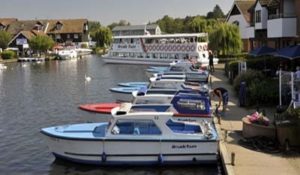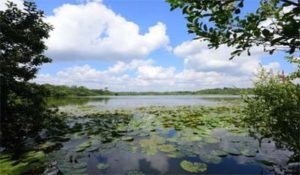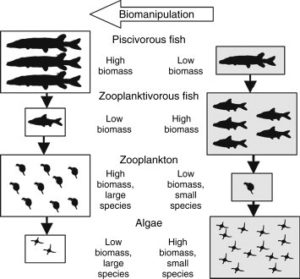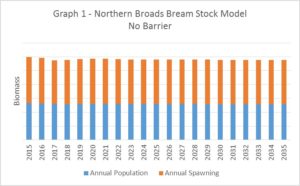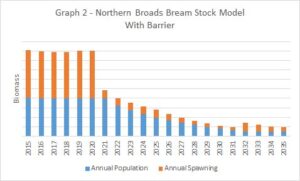Hoveton bio-manipulation statement
The Norfolk and Suffolk Broads has been famous for its ability to support a mix of ecology and recreation and take people out into nature for centuries. The recent decision by the Environment Agency to ignore all the science and issue a permit to its partner Natural England leaves us astounded.
We have agreed with the Angling Trust campaigns team to raise this to the highest level and implement a national campaign to get this stopped, including by legal means from Fish Legal.
The Angling Trust national press release is available here.
The tourism honey pot of Wroxham probably reaching the limits on the balance between people and nature. However you don’t have to travel far to find the other extreme with many Broads left to nature, like Hoveton Great Broad one of jewels of the Broads in terms of its ecology.
In recent times however, man has had an influence on this space, with high nutrient levels and silt ingress as we drain the surrounding land in what is one of the UK’s prime sites of special scientific interest, SSSI.
Natural England are the stakeholders for such places and have over recent years looked at restoration of such waterbodies under a wider defined lake restoration strategy[1], supported by the EU WFD (Water Framework Directive[2] polices.
In essence the lake strategy means some form of dredging and removing many years of silt, containing high levels of nutrients and then enabling a process for clear water by removal of cyprinid fish species by a process called bio-manipulation [3] (Roach and Bream) which induce coloured (turbid) water by the annual juveniles grazing on zooplankton (waterfleas), which feed on algae.
The diagram left shows the linkages across the foodchain.
Change the food chain by removing the spawning fish and the resultant juveniles don’t consume the waterfleas and as such there is less algae to effectively colour the water and enable water plants to flourish.
Well that’s the theory, which has been used in other Broads with limited success.
So what’s the issue you ask?
We are not against the principle of restoration, otherwise we would have objected to all the other schemes currently underway across the Broads. Our objection in this case, is the large-scale fish removal and installation of the fish barrier and isolation of the Broad from the river. The evidence clearly shows that for the past four seasons, very little Bream spawning activity has taken place outside Hoveton Great Broad across the entire Northern Broads Catchment.
Given the strategic importance the Broads has to anglers and the tourism surrounding it as England’s largest inland fishery, angler’s rod licence money has funded a PhD study on the movement and spawning of Bream and Pike in the Northern Broads. This to gain a scientific understanding and evidence on the role that Hoveton Great Broad provides across the whole Northern Broads catchment. We believe the evidence is conclusive that any form of isolation will be damaging to the wider catchment and sustainability of bream in the long term, let alone the underlying bird and manual predatory fish ecosystems that they support.
BASG has produced a model to demostrate the strategic impact of the barrier to annual bream recruitment
The model in graph 1 captures the full 14 year life cycle of bream, their annual mortality and spawning rates, whilst demostrating how nature regulates the natural cycle without human interference.
Much effort has been put into undertaking spawning assessments over the past 3 years in an attempt to understand bream spawning behaviours, this has confirmed low levels of success outside HGB, at less than 1%.
The model in graph 2 reflects the worst case of spawning impact, around 20% success for the planned period of isolation 2020-2030 this reflects the evidence identified in the last 3 years spawning assessments, if HGB is not open to Bream.
Clearly the fishery is destroyed if this approach is adopted and not able to recover, even when the barrier is removed. Is this something that is acceptable in what is England’s largest natural fishery, we believe these fish need some protection from this onslaught by man.
If this barrier model applied to birds, mammals or insects the project would be stopped immediately, and we ask the question why Natural England and their associates consider that Bream are not afforded the same protection within their natural environment. What’s the impact on tourism and social economics here?
Much evidence exists on the social economics surrounding Broads tourism and its revenues of that the annual 8m visitors bring. We know from tourism and stakeholder surveys that 18% of visitors come to the Broads to fish. That’s been estimated a value worth of over £100m per annum to the Broads local economy[4], much of this bringing visitors out of the peak holiday season.

Now that the Environment Agency have seemingly ignored all the evidence and their own world leading fishery
scientists advice on this with the granting of a permit to allow the barriers to be installed.
How can you help?
We have been in active dialogue with both the applicant Natural England and the Competent Authority the Environment Agency for many months on this issue. But they seem to want to forge ahead regardless of the evidence and impact. We and other bodies believe this isolation is working against the principles of the Water Framework Directive, but Natural England believes that protecting a SSSI has a higher value than some European directive, which is actually UK law.
Can you imagine the public outcry if this was some fury animal or bird been restricted from its favoured nesting site? This is our call to arms to raise public awareness of the issue, outside that of the Broads angling community. We have agreed with the Angling Trust campaigns team to raise this to the highest level and implement a national campaign to get this stopped, including by legal means from Fish Legal.
So please spread the word and together we can change this.
The Angling Trust national press release is available here.
On behalf of the Board of Directors BASG CIC
References
[2] http://evidence.environment-agency.gov.uk/FCERM/en/SC060065/About.aspx
[3] https://www.sciencedirect.com/topics/earth-and-planetary-sciences/biomanipulation
[4] https://basg.online/social-economics-of-broads-angling/
The BASG Campaign material is listed at https://basg.online/campaigns/hoveton-gb/


